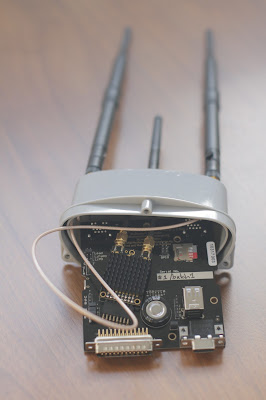It has been a bit delayed with everything going on to report it, but we have the new Mesh Extender prototypes in their shiny injection-moulded cases. Here is Mesh Extender 2.0 serial number #1 (thanks to Rachael from Second Muse for the shots):
These prototypes are almost, but not quite complete. The main outstanding issue is that the D-SUB connectors are not the correct IP67 ones with the seals around them. Thus, while they are ostensibly complete, with the revision 4 PCBs, they are not weather proof enough for deployment. We will fix this with the upcoming revision 5 PCB.
Also, when those shots were taken, we didn't have the correct reverse-SMA connectors with built-in seals to seal the antenna inputs. I am still not at ease that they will seal completely. The other niggling concern I have is that humid air will pass through the goretex seal on the bottom (the black disc in the top image), i.e., only liquid phase water will be excluded. I hadn't previously realised this limitation. Our current approach to these problems is to apply a conformal coating to the revision 5 PCBs, so that with the housing limiting water ingress, and hopefully excluding the ants and other foreign bodies, that the conformal coating will be up to the task. I am confident it will all work out in the end, but this is representative of the many details that come into play when trying to make hardware, and especially if it is to be used in a hostile environment, such as in the middle of a tropical jungle.
I'll also shortly post about their first excursions to New Zealand to a Red Cross exercise, and to Vanuatu, as the first stage of our pilot there.




A smear of silicone grease on the outside of the SMA connectors once mated will keep water out for a few months. You can fill the D connectors with grease.
ReplyDelete